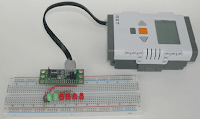 The wonderful folks over at HiTechnic have released a new offering that will interest electronics beginners, science teachers, and advanced tinkerers with a very cool way to play, learn, and create! HiTechnic's Experimenter's Kit A with the Solderless Phototype Sensor Board will enable you to go far beyond what LEGO has in mind for the NXT. The HiTechnic Experimenter's Kit A is a clean and easy way to integrate the LEGO MINDSTORMS NXT with the world of homebrew electronics and circuits while keeping your NXT warranty intact. Crack into the potential of the NXT without cracking the NXT! Control something with the NXT...Have something control the NXT! Prototype the next big 3rd-party sensor! Bend the NXT, some circuits, and your mind!
The wonderful folks over at HiTechnic have released a new offering that will interest electronics beginners, science teachers, and advanced tinkerers with a very cool way to play, learn, and create! HiTechnic's Experimenter's Kit A with the Solderless Phototype Sensor Board will enable you to go far beyond what LEGO has in mind for the NXT. The HiTechnic Experimenter's Kit A is a clean and easy way to integrate the LEGO MINDSTORMS NXT with the world of homebrew electronics and circuits while keeping your NXT warranty intact. Crack into the potential of the NXT without cracking the NXT! Control something with the NXT...Have something control the NXT! Prototype the next big 3rd-party sensor! Bend the NXT, some circuits, and your mind!HiTechnic has added The Experimenter's Kit Handbook…a fantastic guide full of detailed step-by-step projects teaching beginner electronics and sensor prototyping on the included Solderless Breadboard. This handbook provides a wonderful way for Mindstormers to learn about electronics and have fun at the same time. They have included enough components to build 8 experiment projects detailed in the Experimenter’s Kit Handbook, every one providing many different educational aspects of user electronics. Each chapter of the handbook explains how to identify the components, construct the project’s circuit, and run an example program. Programming examples and custom blocks for NXT-G, LabVIEW, NXC, and RobotC are available for each project.
 The real treat is that this kit allows experimenters to design and build custom circuits and sensors to interact with the NXT through a normal cable connection. If you create something worth saving permanently, try their Solderable Prototype Board.
The real treat is that this kit allows experimenters to design and build custom circuits and sensors to interact with the NXT through a normal cable connection. If you create something worth saving permanently, try their Solderable Prototype Board.Take a Look! The Experimenter’s Kit A Handbook and sample programs are available for download here. Look through it and let the ideas flow! If you create something, send me some details and I'll post it to the blog.
I’m in the process of reviewing this kit and going beyond the kit projects by spinning it through a few of my own dark experiments and homebrews. In the coming months I’ll show off what’s being twisted in my own secret lab. (covert photo..)
Christopher R. Smith
Littlehorn